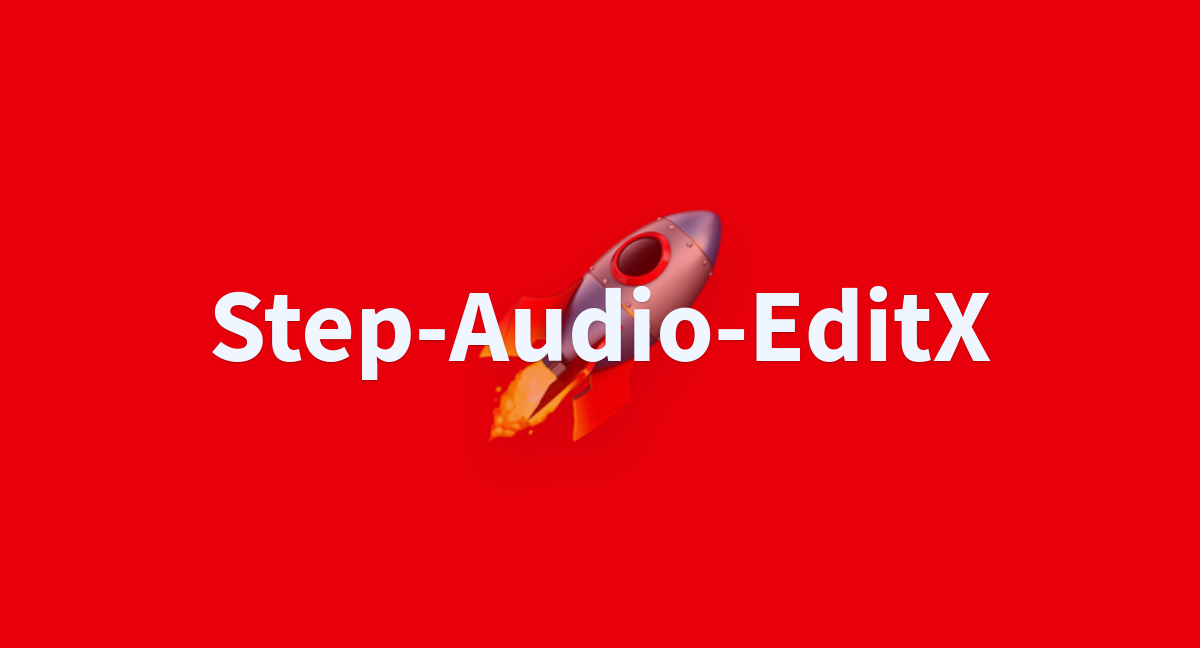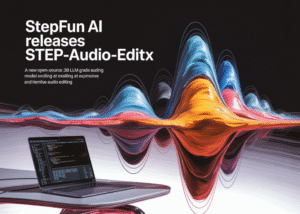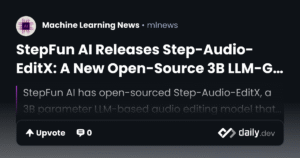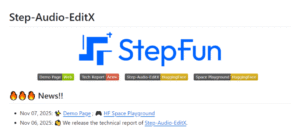StepFun AI Releases Step-Audio-EditX — An Open-Source, 3B-Parameter Audio LLM for Expressive, Text-Like Speech Editing
Introduction
Audio editing has long lagged behind text and image generation in terms of intuitive control. Most pipelines still rely on waveform-level manipulation, disentanglement encoders, or multi-stage adapters that make fine-grained changes feel brittle and slow. StepFun AI’s Step-Audio-EditX changes that dynamic by reframing speech editing as a token-level, text-like operation—letting you direct emotion, style, and even paralinguistic details (like breaths, laughs, or sighs) with plain language prompts. The model, open-sourced at 3B parameters, also provides robust zero-shot TTS and supports iterative editing workflows for production use. Hugging Face+2arXiv+2
In this article, we unpack what Step-Audio-EditX is, how it works, what’s novel about its training approach, practical use cases, early benchmarks, and how to get started with the freely available model and demo.
What is Step-Audio-EditX?
Step-Audio-EditX is an open-source, LLM-based audio model built by StepFun AI for expressive and iterative audio editing. Instead of grafting style encoders or adapter modules onto a TTS backbone, it uses a large-margin learning strategy on synthetic data to make emotion and style controllable directly through post-training, without embedding priors or auxiliary modules. The result: fine-grained, promptable control over voice attributes while preserving transcript fidelity. arXiv+1
Key capabilities highlighted in the technical report and release materials include:
-
Text-like editing of speech at the token level (rather than waveform-level DSP).
-
Expressive control over emotion, speaking style, and paralinguistics (e.g., laughter, sighs, breaths).
-
Zero-shot TTS with robust voice fidelity from brief references.
-
Iterative editing that supports production workflows (edit, audition, revise). Hugging Face+1
StepFun AI has published both a Hugging Face repository (weights + usage) and a Hugging Face Space (interactive demo) so developers can try the system quickly. Hugging Face+1
Why Step-Audio-EditX Matters
Text and image generation reached “directability” once models internalized semantics and style in a way prompts could control. In speech, this directability has been elusive: current zero-shot TTS systems can sound natural but often fail to hit precise emotional targets (e.g., “calm but urgent,” “subtle sarcasm,” “comforting with a smile”). Prior methods typically bolt on separate disentanglement modules, which can be fragile or domain-limited.
Step-Audio-EditX proposes a different route: change the training objective and data structure so the base model learns to transform the same transcript into meaningfully different emotional and stylistic realizations. This is where large-margin synthetic data and the iterative control approach come in. arXiv
For teams building dubbing pipelines, audiobooks, learning content, IVR agents, or in-game voice, the promise is faster iteration with fewer bespoke components—bringing speech editing closer to the simplicity of rewriting text.
Under the Hood: Architecture and Tokenization
Step-Audio-EditX is a 3B-parameter audio LLM. It uses dual codebook tokenizers—a design lineage from the Step-Audio family—to represent speech as interleaved token streams that separate linguistic content from fine-grained semantic/prosodic cues:
-
Language stream: ~16.7 Hz sampling, 1024 tokens
-
Semantic stream: ~25 Hz sampling, 4096 tokens
-
Streams interleave at a 2:3 ratio, preserving prosody and emotional features while keeping content aligned. news.aibase.com
The model is initialized from a text LLM, trained on a mixed corpus with an approximate 1:1 ratio between text tokens and audio tokens. Crucially, the model can read text or audio tokens and always outputs dual codebook token sequences, directly supporting both TTS and editing tasks in one unified backbone. news.aibase.com
This architecture is what enables token-level “edits”—you modify tokens (via prompts and guidance) rather than performing delicate waveform surgery. The approach is conceptually similar to how modern image diffusion systems let you iterate on latent tokens instead of pixels.
The Training Idea: Large-Margin Learning on Synthetic Data
Instead of meticulously disentangling representations, Step-Audio-EditX leans on large-margin synthetic data. The training process presents the model with pairs, triplets, or quadruplets of the same transcript spoken with significantly different attributes (e.g., neutral vs. angry vs. playful). The objective pushes the model to maintain textual content while learning to transform between these stylized renderings. arXiv+1
This approach aims to:
-
Reduce reliance on auxiliary modules (no extra style encoders/adapters)
-
Make post-training enough to unlock controllability
-
Enable iterative edits—because the model understands “distance” between styles, it can move speech along attribute gradients (e.g., “a bit more warmth,” “dial back the sarcasm”) arXiv
The technical report emphasizes that this strategy eliminates the need for representation-level disentanglement, arguing that control can emerge from data and objectives rather than architectural complexity. arXiv
Early Benchmarks and Comparative Results
In the paper, the authors report that Step-Audio-EditX surpasses strong baselines (e.g., MiniMax-2.6-hd, Doubao-Seed-TTS-2.0) on emotion editing and other fine-grained control tasks. While independent replications will be important, these early signals suggest the large-margin strategy does yield practical gains in expressivity and editability. arXiv
Because the model is open-source, the community can scrutinize methods, datasets, and evaluation protocols, and stress-test across languages, accents, and domains.
What You Can Do with Step-Audio-EditX
Here are concrete workflows where Step-Audio-EditX’s strengths matter:
-
Audiobook production
-
Start with a zero-shot voice cloned from a short reference sample.
-
Generate a baseline read, then iteratively edit specific lines: “make Chapter 3’s confrontation more restrained but tense,” or “add a gentle smile into the final paragraph.”
-
Use paralinguistic cues: a subtle sigh before a confession; a brief breath before a revelation. Hugging Face
-
-
Game dialog & NPCs
-
Maintain a consistent character voice while varying emotion and style across quest states.
-
Nudge attributes during playtesting (“push 10% more frustration in the third utterance”). arXiv
-
-
Localized dubbing
-
Preserve semantic alignment with the script while fitting culturally appropriate prosody and intonation.
-
Iterate quickly on director feedback without re-recording. MarkTechPost
-
-
Conversational agents / IVR
-
Adjust tone by context: empathetic for support, energetic for sales, calm for compliance messaging.
-
Inject natural paralinguistics to reduce robotic cadence. Medium
-
-
Education & training
-
Keep the same tutor voice, vary pace and warmth for different age groups or subject difficulty.
-
Add clarifying breath or pause to mark key concepts. news.aibase.com
-
Editing as Iteration: How a Session Might Flow
A typical Step-Audio-EditX workflow (using the demo Space or your code) could look like:
-
Reference & Script
-
Provide a short reference clip (for zero-shot voice) or choose a stock voice.
-
Supply the text to be spoken.
-
-
Initial Generation
-
Prompt for baseline style: “neutral, clear, teacher-like, medium pace.”
-
-
Iterative Edits
-
On specific lines, refine with natural language:
-
“More warmth and reassurance.”
-
“Add a faint smile and slight breath at the start.”
-
“Reduce sarcasm; keep confident.”
-
-
Re-audition and continue until the take matches the creative direction.
-
-
Export
-
Download the audio or tokens for downstream post-production. Hugging Face
-
This “type → listen → tweak” loop mirrors how writers revise copy—bringing speech editing into mainstream creative rhythms.
Getting Started: Repos, Demo, and Setup
Try it fast: StepFun AI hosts a Hugging Face Space where you can upload a clip, enter text, and experiment with edits in-browser. This is the fastest way to get a feel for the model’s promptability and iterative control. Hugging Face
Dive deeper: The Hugging Face repo contains model cards, usage instructions, and links to the technical report. You’ll also find guidance for running inference locally or on a GPU instance. Keep an eye on the org’s GitHub for related projects (e.g., Step-Audio 2) and ongoing updates. Hugging Face+1
Read the paper: The arXiv technical report details training setup, the large-margin objective, tokenization design, and evaluation results. If you’re prototyping research or a production pipeline, it’s worth reading cover-to-cover to understand assumptions and limitations. arXiv+1
Prompt Patterns That Work Well
While every project is different, these prompt patterns tend to produce reliable edits:
-
Attribute bundles
-
“Professional, friendly, measured pace, soft consonants, gentle smile.”
-
“Urgent but not panicked; clipped delivery; slight breath before key terms.”
-
-
Comparative nudges
-
“Same voice, 20% more enthusiasm.”
-
“Dial down sarcasm a little; keep confidence.”
-
-
Paralinguistic cues
-
“Brief laugh on the second sentence.”
-
“Sigh at the start, then composed and calm.”
-
-
Prosodic guidance
-
“Longer pauses between clauses; emphasize technical terms.”
-
“Softer endings; avoid upward inflection on statements.”
-
Because Step-Audio-EditX was designed for token-level transformations, it responds especially well to precise, layered instructions that combine emotion, style, and delivery. arXiv
Practical Considerations and Limitations
-
Voice cloning ethics & consent
-
Even with zero-shot cloning, ensure you have legal rights and explicit consent to use any voice. Implement watermarking or disclosure where appropriate.
-
-
Dataset bias
-
As with any generative model, output quality can vary across languages, accents, or underrepresented speaking styles. Evaluate thoroughly for your use case. arXiv
-
-
Latency vs. quality trade-offs
-
3B parameters is compact relative to giant LLMs but still non-trivial for real-time systems. Optimize inference with quantization and caching when deploying at scale. (Community forums already show early attempts to build/run the stack on common GPU setups.) NVIDIA Developer Forums
-
-
Evaluation standards
-
Reported gains over other models are promising, but broader, independent benchmarks—especially human listening tests across multiple languages—will build confidence. arXiv
-
How Step-Audio-EditX Compares Conceptually
-
Versus classic TTS + style encoders:
Traditional stacks add disentanglement as separate modules. EditX claims similar or better control without those modules by reformulating training and data. This can simplify engineering and reduce failure points. arXiv -
Versus diffusion/vocoder pipelines:
Diffusion-based methods can achieve great naturalness but may require multi-stage inference and specialized fine-tuning for style control. EditX’s token-level framing aims for directability first, then naturalness—striking a practical balance for iterative creative work. arXiv -
Versus closed, server-side APIs:
EditX is open-source, giving teams more control over customization, deployment, and data privacy. The community can also extend tokenizers or objectives to handle new paralinguistic categories. Hugging Face
Example Project Blueprint (Production-Oriented)
Objective: Build a multilingual training video narrator that keeps the same persona while adapting tone and emotion across modules and regions.
Stack outline:
-
Frontend: Web app where producers paste scripts and annotate lines with style tags (e.g., “Encouraging | Moderate Energy | Smile”).
-
Back end:
-
Step-Audio-EditX inference service with queued jobs.
-
Token cache for frequently used voices.
-
Prompt compiler that converts annotations into structured prompts (with paralinguistic markers).
-
-
QA loop:
-
Automatic prosody checks (pause length, rate) + manual review via A/B players.
-
Iterative prompts applied per line; changes tracked as “diffs” in metadata (useful for legal/audit).
-
-
Delivery:
-
Final audio + aligned captions.
-
Store style recipes to reuse across updates. Hugging Face
-
This blueprint plays to EditX’s strengths: iterative control, token-level diffs, and promptable paralinguistics.
Community Momentum and Ecosystem
Within days of the release, write-ups and news posts began circulating (e.g., MarkTechPost, AIBase), and community discussions popped up across forums, which is a good sign for early adoption and extension. Expect guides, prompt libraries, and quality tests to emerge as more teams experiment. MarkTechPost+2news.aibase.com+2
On the StepFun AI GitHub, you can also explore related audio and multimodal projects (like Step-Audio 2) that hint at a broader roadmap for production-grade audio understanding and generation. GitHub
Quick Start: Links & Resources
-
Model & Usage: Hugging Face model card for stepfun-ai/Step-Audio-EditX. Hugging Face
-
Interactive Demo: Hugging Face Space to try edits in the browser. Hugging Face
-
Technical Report: arXiv:2511.03601 (HTML/PDF). arXiv+1
-
Community Coverage: MarkTechPost explainer and AIBase launch summaries. MarkTechPost+1
Final Thoughts
Step-Audio-EditX signals a shift in speech technology: rather than bolting on modules to chase controllability, it bakes control into the base model via data and objectives. For practitioners, the impact is tangible—fewer moving parts, faster iteration, and more faithful emotional/style direction from simple prompts.
If you produce voice content at scale—localization studios, game teams, edtech, support AI—this is a release to test now. Start with the public demo to get a feel for token-level editing, then wire the model into a pilot pipeline. The combination of open weights, arXiv documentation, and an active community makes Step-Audio-EditX one of the most practical, creator-friendly advances in speech we’ve seen this year. Hugging Face+2Hugging Face+2
FAQ
1) Is Step-Audio-EditX only for English?
The release materials emphasize method and architecture more than language coverage. Expect best performance in high-resource languages first; test your language/accent and fine-tune if needed. arXiv
2) Can I clone a voice from a short sample?
Yes—zero-shot TTS is supported. Always obtain consent and comply with local regulations on voice likeness. Hugging Face
3) How “iterative” is the editing?
The model is explicitly designed for iterative control, allowing repeated, small edits to converge on a target performance. arXiv
4) What hardware do I need?
A single modern GPU can be sufficient for inference with a 3B model, though throughput and latency vary by setup. Community posts already discuss builds and environment quirks. NVIDIA Developer Forums
5) How does it compare to diffusion-based TTS?
Approaches differ. EditX optimizes promptable control via token-level operations and large-margin training, which can simplify pipelines and speed iteration. Subjective quality will depend on your domain; A/B test against your current stack. arXiv
For quick updates, follow our whatsapp –https://whatsapp.com/channel/0029VbAabEC11ulGy0ZwRi3j
https://bitsofall.com/comparing-top-7-large-language-models-llms-for-coding-2025/
Anthropic Turns MCP Agents Into Code-First Systems With the ‘Code Execution with MCP’ Approach
Kimi K2 Thinking by Moonshot AI — A New Era of Thinking Agents







